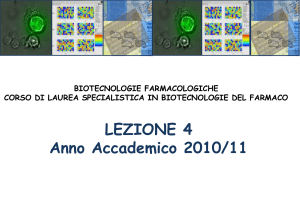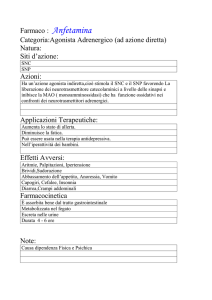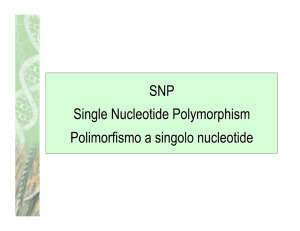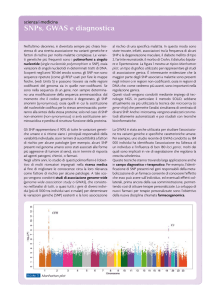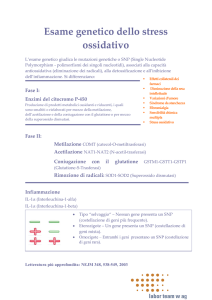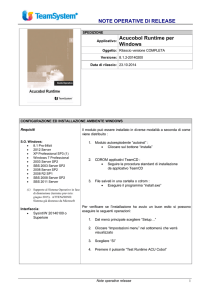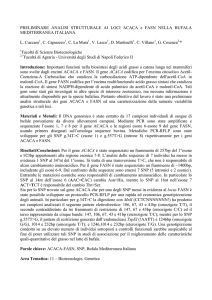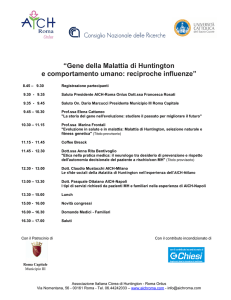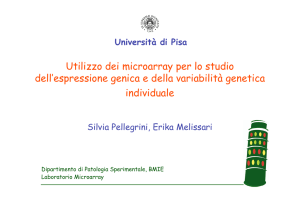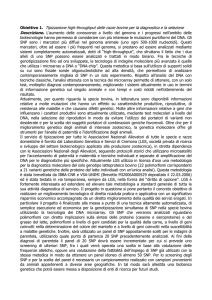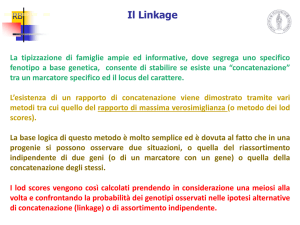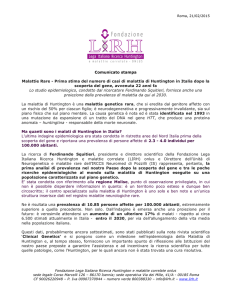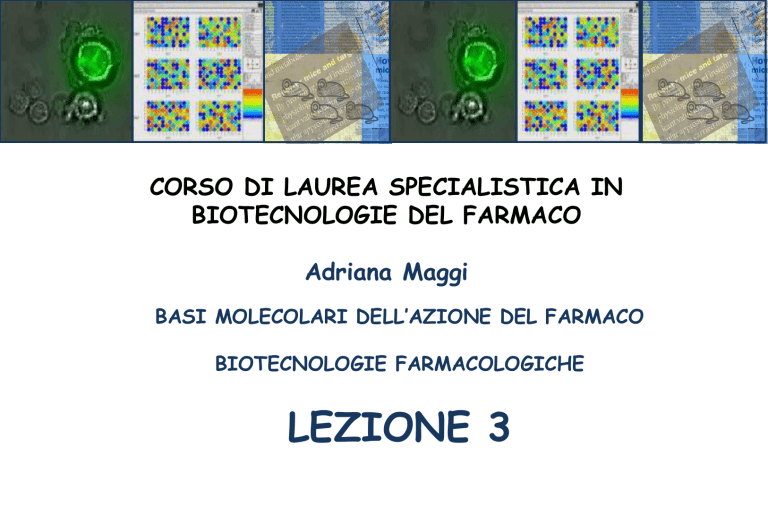
CORSO DI LAUREA SPECIALISTICA IN
BIOTECNOLOGIE DEL FARMACO
Adriana Maggi
BASI MOLECOLARI DELL’AZIONE DEL FARMACO
BIOTECNOLOGIE FARMACOLOGICHE
LEZIONE 3
Riassunto lezione n° 2
Metodi della genomatica – il Progetto Genoma Umano e sue
immediate conseguenze nel mondo della biologia.
GENOMATICA FUNZIONALE
Studio di funzione genica
I farmaci attualmente sul mercato
agiscono su circa 500 prodotti genici
Considerando che il genoma umano
contiene circa 30.000 geni che
codificano per proteine, il potenziale
per lo sviluppo di nuovi farmaci è
evidente
LA RICERCA DELLA FUNZIONE DEI GENI
La tradizione:
ricerca di di mutazioni per identificare perdite o
acquisizione di funzioni
I metodi della genetica all’incontrario:
Generare nuovi organismi geneticamente
modificati per studiare perdita o acquisizione di
funzioni
Metodologie innovative:
Studio comparativo di popolazioni di prodotti
genici
La tradizione:
ricerca e analisi di mutazioni e polimorfismi
(es RFLP; SNP) del genoma stesso
Siti polimorfici
• 99.99 % della sequenza del DNA di due
individui e’ identica
• la maggioranza delle differenze (0.01%)
coinvolgono singole sostituzioni
Polimorfismi al taglio con enzimi di restrizione (RFLP)
Single nucleotide polymorphysm (SNP)
Polimorfismi al taglio con enzimi di
restrizione (RFLP)
Allele 1
*
Allele 2
Polimorfismi al taglio con enzimi di
restrizione (RFLP)
associazione RLFP-patologia
variab nella popol.
Famiglia Patol.
sani
The Lod (log of odds) score (typically called logit by
mathematicians) is used to calculate the probability of a
pedigree arising randomly or by genetic linkage. The test was
developed by Newton and Morton
LOD = log
Probability of birth sequence with a given linkage value
Probability of birth sequence with no linkage
In practice, linkage is declared if the LOD score is equal to or
greater than 3 (i.e. the likelihood of observing the result if the
two loci are not linked is less than 1 in 1000). On the other
hand, linkage can be completely excluded if the LOD score is
strictly below -2.
CROSSING OVER TRA CROMOSOMI
Thomas Hunt Morgan's illustration
of crossing over (1916)
Studio di funzione genica
Localizzazione posizionale di geni/malattia
Studio di linkage familiare con polimorfismi
Chromosomal walking
Huntington, la malattia ideale per position cloning
Inheritance pattern – dominant autosomal Entirely penetrant and fatal
Frequency - about 1/10,000 live births
Late onset - age 35 to 45
Because of late onset, many have children before symptoms appear
Families with a history of Huntington's disease :
Indiana University maintains a National Research Roster for
Huntington's Patients
Large family with a history of Huntington's disease discovered living
on shore of lake Maracaibo in Venezuela
For both families with a history of Huntington's disease:
Blood samples taken from each member
Permanent cell lines established
Each family member analyzed by a neurologist for disease symptoms
Paternity verified
1981 - Gusella's group started with a group of anonymous probes that
uncovered RFLPs - very few available.
the 12th probe they tried -called G8 - indicated linkage.
Disease associated with the A haplotype in the American family and
the C haplotype in the Venezuelan family.
LOD Scores
1983 - G8 (also called D4S10) mapped approximately 4 cM from the
HD locus. It took 10 more years to clone the gene.
1986-87 DNA markers were used and D4S10 was localized by in situ
hybridization and somatic cell genetics to chromosome region 4p16.3;
Further linkage studies for isolating HD
Identification of Putative Coding Sequences
Exon Trapping; Use trapped exons to identify candidate genes from
cDNAs; Four transcripts were analyzed; IT15 - Huntingtin
Gusella JF, Wexler NS, Conneally PM, Naylor SL,
Anderson MSA, Tanzi RE, Walkins PC, et al (1983) A
polymorphic DNA marker genetically linked to
Huntington's disease. Nature 306:234-238
Huntingtin DNA, protein and uses thereof
US Patent Issued on November 11, 1997
Inventor(s): Marcy E. MacDonald; Christine M. Ambrose; Mabel P.
Duyao; James F. Gusella
Assignee: The General Hospital Corporation
Application: No. 246982 filed on 1994-05-20
LE PRIME AZIENDE BIOTECNOLOGICHE
Sequana Therapeutics
History:
Sequana Therapeutics (expertise: finding new genes eg.
obesity and melanoma) was acquired by Arris
Pharamceuticals for $ 166 million, forming Axys
Pharmaceuticals.
Axys went on to form Axys Advanced Technologies, which
got bought by ChemRx, becoming ChemRx Advanced
Technologies. The remains of Axys were bought by Celera
and now operates as Celera South San Francisco. Celera is
now part of Applera
Myriad Genetics Salt Lake City
– 657 impiegati
vendite 2005: $84,2 milioni
Myriad Genetics is working on figuring out which ones you will get. Its
tests can determine a patient's risk for breast or ovarian cancer
(BRACAnalysis), skin cancer (MELARIS), and colon cancer
(COLARIS). The company is also developing treatments for some of
those myriad diseases. With such partners as Abbott Laboratories
and E.I. du Pont de Nemours, Myriad is developing drugs for cancer,
AIDS, and other diseases. Its lead drug candidate Flurizan is in Phase
III clinical trials as a treatment for Alzheimer's disease. Other
drugs being developed include brain tumor candidate MPC-6827 and
blood cancer candidate MPC-2130.
Metodologie innovative:
Studio comparativo di popolazioni di
prodotti genici
• genomatica comparativa
• studio di SNP
• generazione di arrays per lo studio
comparato di espressione genica
Studio di funzione genica
Genomatica comparativa:
analisi basata sulla omologia con
proteine a funzione nota
Ortologo e paralogo
• Ortologhi – geni omologi con la stessa
funzione in organismi diversi
• Paraloghi – geni all’interno dello stesso
organismo derivanti da duplicazione genica
Geni ortologhi o paraloghi
The ACT Display
genome1
Zoom scroll bar
Filter scroll
bar
genome2
Genome2
Blast HSPs
genome3
Fino a qui lezione terza
ARRAY
MACROARRAY
MICROARRAY
DNA microarray (o gene/genome chip,
DNA chip, o gene array) è una collezione di
depositi puntiformi di DNA, ciascun punto
rapresentante un singolo gene
immobilizzati su un supporto (vetro,
plastica o silicone) mediante legami di tipo
irreversibile.
Esempio di microarray con 40.000 oligo
immobilizzati su supporto solido e ibridati con cDNA
APPLICAZIONI DI ARRAY:
• SNP detection arrays - Looking for Single nucleotide polymorphism
in the genome of populations
• comparative genomic hybridization (Array CGH) - Assessing large
genomic rearrangements.
• mRNA or gene expression profiling - Monitoring expression levels
for thousands of genes simultaneously is relevant to many areas of
biology and medicine, such as studying treatments, disease, and
developmental stages. For example, microarrays can be used to
identify disease genes by comparing gene expression in diseased and
normal cells (reference?).
• Chromatin immunoprecipitation (chIP) studies - Determining protein
binding site occupancy throughout the genome, employing ChIP-onchip technology
Siti polimorfici per singola sostituzione di
base (SNP)
Individuo 1
Individuo 2
Perchè una variazione possa essere considerata un SNP
deve essere presente in almeno l’1% della popolazione
Gli SNP sono la causa di circa il 90% della variabilità
genetica umana ed in genere si trova uno SNP ogni 100300 pb. 2/3 SNP vedono sostituita la C con T.
Siti polimorfici per singola sostituzione
di base (SNP)
•di http://www.ncbi.nlm.nih.gov/About/primer/snps.html
base
Nel genoma umano ci sono 200.000 SNP
all’interno di sequenze codificanti
Metodi di identificazione di SNP
IBRIDAZIONE ALLELE-SPECIFICA
REAZIONE DI ELONGAZIONE DI PRIMER
FISSATO SU SUPPORTO SOLIDO
Studio di funzione genica
Studio di trascrittoma (trasncriptomics)
Studio di proteoma (proteomics)
Studio di metaboloma (metabolomics)
Studio di interattoma
H. sapiens
Drugs x Cells
Genes x Cells
Clustered Image Maps
Genes x Drugs
Database Microarray Experiment Sets
Sample Profiles as of Date
Genomics and bioinformatics
group
NCI and NIH
Chip-on-chip analysis per lo studio
delle interazioni DNA proteine

